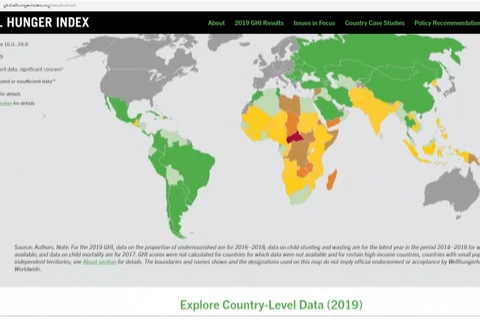 A set of premature triplets were saved by Hung Vuong Hospital doctors. (Photo courtesy of the hospital)
A set of premature triplets were saved by Hung Vuong Hospital doctors. (Photo courtesy of the hospital) HCM City (VNS/VNA) - Advances in treatment at hospitals nationwide have helped save more and more premature infants who are at high risk of mortality.
This improvement is in line with the United Nations' fourth Millennium Development Goal to reduce child mortality rates.
“Preterm birth complications are the leading cause of death among children under 5 years of age, responsible for approximately 1 million deaths in 2015. Three-quarters of these deaths could be prevented with current, cost-effective interventions,” the World Health Organisation (WHO) said.
Many hospitals in Vietnam have improved their treatments for low birth-weight babies.
Hung Vuong Hospital in HCM City, for instance, has been able to save thousands of premature infants each year. The survival rate of babies born between 24 and 37 weeks of pregnancy is now up to 90 percent.
The latest premature infants who were saved by the hospital were triplets from the south-central coastal province of Bình Thuận born at 26 weeks and five days of pregnancy.
The mother was hospitalised and closely monitored because she had underlying diseases.
At 26 weeks and five days in the pregnancy, the hospital’s doctors decided to perform Caesarean surgery. The babies weighed 785 grammes, 850 grammes and 860 grammes.
The three babies showed signs of respiratory failure due to pneumonia and were placed in the neonatal department. They also suffered from neonatal infections. Two of them received blood transfusions, while one suffered from enteritis.
The hospital’s doctors treated them for over 91 days and used the Kangaroo Care method in which there is warm skin-to-skin contact with the babies to help maintain their body temperature, respiration and digestion.
The doctors also were able to save a male infant weighing 800 grammes born after 25 weeks of pregnancy.
"The case from Phu Nhuan district was very premature and suffered from severe respiratory failure. Saving him was rather impressive. It took 124 days to feed and raise him successfully," doctors said.
The hospital successfully saved another male infant weighing 700 grammes and another weighing 500 grammes. They were also premature births.
The 700-gramme infant was diagnosed with retinopathy of prematurity, which is a potentially blinding disease caused by abnormal development of retinal blood vessels in premature infants. The infant also had respiratory failure due to pneumonia.
After birth, the male infant was put in an incubator and on a ventilator for 71 days. For the next 22 days, he used continuous positive airway pressure instead of a ventilator.
The Kangaroo Care method was also used for one month. After 123 days of treatment, he was discharged from the hospital weighing 2,230 grammes.
However, because of premature birth, his parents had to continue the Kangaroo Care method and visit the hospital for follow-up examinations.
Besides taking care of premature infants in incubators and using continuous positive airway pressure, successful treatment depends on many factors.
The infants have to be closely watched and cared for by nurses and doctors, and the mothers’ role in following weeks is also very important.
The Kangaroo Care method is very effective in helping to save these infants, doctors said.
They are fed breast milk to help prevent infections and improve digestion. The infants usually have contact with their mothers to stimulate the development of the brain and nervous system and to reduce the mortality rate and chance of disease.
Tu Du Hospital in HCM City and Da Nang Hospital for Women and Children have set up human milk banks to help premature babies.
Previously, these babies had to use formula milk.
The deputy head of the HCM City’s Department of Health, Tang Chi Thuong, said the Tu Du Hospital milk bank would help reduce the number of premature babies with necrotising enterocolitis disease in which the gastrointestinal tract results in inflammation and bacterial invasion of the bowel wall.
Dr Le Quang Thanh, the hospital director, said: “Among nearly 70,000 births at the hospital every year, 6,000 to 7,000 are premature and have health problems. They need breast milk to provide nutrients for treatment and recovery.”
Healthy mothers who have more than enough breast milk can volunteer to donate their milk to the bank.
The hospital will set up appointments for screening and testing before the donation. After testing, the breast milk is collected and transported to the bank for pasteurisation and storage.
Donated breast milk at the bank is pasteurised under domestic and international standards.
According to UNICEF, Vietnam has had significant progress in raising the survival ratio of children under five years old within the last 25 years. The ratio was 52 per 1,000 children in 1990, dropping to 12 per 1,000 children in 2018.
“However, infant mortality rates in the North and Central Highlands remain high and in some provinces, such as Lai Chau and Kon Tum, the rates are three times higher than the national average.
“It is estimated that 47 newborns die every day in Vietnam. Most are from preventable causes. Simple interventions such as skilled birth attendance, early essential newborn care, early initiation of breastfeeding, and kangaroo-mother care for premature and low-weight babies can save lives of women and their infants," UNICEF said.
The first 28 days of life – the neonatal period – is the most vulnerable time for a child’s survival. Children face the highest risk of dying in their first month of life at an average global rate of 18 deaths per 1,000 live births in 2018, according to UNICEF./.
VNA






















